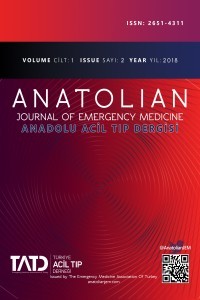
Anatolian Journal of Emergency Medicine
Yazarlar: Omer SALT, Sule YAKAR, Polat DURUKAN, Necmi BAYKAN, Nuri TUTAR, Mustafa Burak SAYHAN
Konular:-
Anahtar Kelimeler:Emergency medicine,Intravenous thrombolysis,Pulmonary embolism
Özet: Aim: In this study we aimed to evaluate the demographic characteristics, comorbid conditions, risk factors, laboratory findings, imaging results, risk scores, post-treatment complications and outcome patterns of patients who received t-PA treatment for pulmonary thromboembolism in emergency department. The second aim of the study was both the evaluation of treatment efficacy and the determination of which parameters could be used to determine the patient group at risk. Material and Methods: Individuals diagnosed PE and treated with thrombolytic agents in a tertiary emergency department of university hospital were included into this retrospective study. Complaints at admission, demographic data, biochemical results, radiological findings, clinical features and outcome were analyzed. Wells scores were calculated from the medical records of the patients. In addition, the medical treatment, complications and termination methods of the patients after thrombolytic therapy were evaluated. PESI values of patients included in the study were calculated and prognosis was evaluated. Results: Fifty-nine patients were included to this study. Of 59 patients, 30 (50.8%) were female and 29 (49.2%) were male. Mean age was 58.1 (Range: 18-84; SD: 18). Clinical grading of patient cohort revealed 31 (52.5%) high-risk PE patients and 28 (47.5%) low- risk PE patients. There were no statistically significant differences between high- and low-risk PE patients in terms of demographic and clinical data (p>0.05). PESI score was high in high-risk group (24 vs 9, p <0.01). Rate of complications, and outcome between high- and low-risk groups showed no statistically significant differences (p>0.05). Conclusion: With the exception of a higher PESI score in high- risk PE group, we determined no expected correlation between pulmonary embolism risk scoring systems and post-treatment complications of pulmonary embolism.